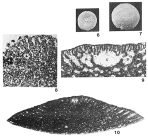Foraminifera taxon details
Palorbitolina Schroeder, 1963 †
739383 (urn:lsid:marinespecies.org:taxname:739383)
accepted
Genus
Orbitolina (Palorbitolina) Schroeder, 1963 † · unaccepted (Opinion of Schroeder (1964) Nomen...)
Opinion of Schroeder (1964) Nomen translatum
marine, brackish, fresh, terrestrial
fossil only
feminine
(of Orbitolina (Palorbitolina) Schroeder, 1963 †) Schroeder, R. (1963). Palorbitolina, ein neues Subgenus der Gattung Orbitolina (Foram.). <em>Neues Jahrbuch für Geologie und Paläontologie, Abhandlungen.</em> 117: 346-359.
page(s): p. 348 [details] Available for editors [request]
[request]
page(s): p. 348 [details] Available for editors
Hayward, B.W.; Le Coze, F.; Vachard, D.; Gross, O. (2024). World Foraminifera Database. Palorbitolina Schroeder, 1963 †. Accessed at: https://marinespecies.org/Foraminifera/aphia.php?p=taxdetails&id=739383 on 2024-04-24
Date
action
by
original description
(of Orbitolina (Palorbitolina) Schroeder, 1963 †) Schroeder, R. (1963). Palorbitolina, ein neues Subgenus der Gattung Orbitolina (Foram.). <em>Neues Jahrbuch für Geologie und Paläontologie, Abhandlungen.</em> 117: 346-359.
page(s): p. 348 [details] Available for editors [request]
[request]
page(s): p. 348 [details] Available for editors
From editor or global species database
Diagnosis Low conical test relatively small, up to 5 mm in diameter, embryonal apparatus consisting of protoconch and deuteroconch, overlying supraembryonal zone subdivided in the outer part by partial vertical septula, the resulting chamberlets opening into the underlying proloculus, laterally a periembryonal ring of obliquely arranged chamberlets borders the proloculus and supraembryonal zone, periembryonal chamberlets similarly subdivided by septula in the upper part, later chambers uniserial and discoidal, with thin marginal zone of primary vertical exoskeletal beams and horizontal rafters, and may be accompanied by secondary beams in the later chambers, poorly developed radial zone occupies one-third to one-half the chamber area, the main beams being thick and triangular in section and zigzagging irregularly toward the central region, main partitions irregular and intermittant in the central complex; wall imperforate, of granular calcite, with large quantity of fine-grained agglutinated material near the surface and coarser-grained in the inner zone; apertural pores obscure. L. Cretaceous (U. Barremian to Aptian); France; Italy; Bulgaria: Spain; Tibet; Iraq; Qatar Peninsula; Iran; Syria; Lebanon. (Loeblich & Tappan, 1987, Foraminiferal Genera and Their Classification) [details]


